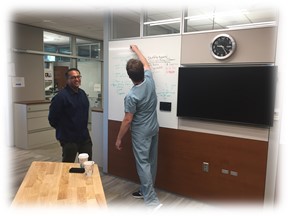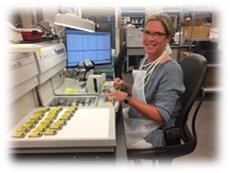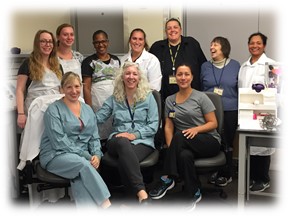DOP Update: The Door is Open to Possibilities at NCRC
By Jeffrey Myers, MD | 22 August | Department of Pathology Updates, Vol 4 (1)
Teammates,
Welcome to the latest edition of DOP Updates, a periodic email sent to members of our Department of Pathology (DOP) and other stakeholders to share information of common interest. Updates are also [linked] as a PDF file to preserve format across your mobile devices. Please send me a note if you have something that you would like to share regarding this or any future editions of Updates.
NCRC
You did it!! In various ways each and every one of you participated in one of the most significant shifts in the history of our department – you executed the relocation half of our PRR (Pathology Relocation and Renovation) project. To the numerous staff, trainees and faculty who worked hard to make it a reality we owe a debt of gratitude. To one another we owe civility, compassion, and kindness as together we struggle to right the things that went wrong and return to a place of stability in which our focus, as always, can remain first and foremost on those who we are privileged to serve.
 Already we are beginning to see some of the possibilities created at NCRC, measured not so much in terms of rewired workflows and logistics but instead by human interactions. We have, all of us, emigrated from geographically distributed care teams for whom parochial interests framed disparate and customized workflows and cultures. What worked in one place was done differently in another to the satisfaction of all participants. With our co-location of much of our clinical operations, we have new opportunities to re-think the power of standard work while also acknowledging the cost to individual prerogatives and the very human desire to preserve the standalone solutions long familiar to us.
Already we are beginning to see some of the possibilities created at NCRC, measured not so much in terms of rewired workflows and logistics but instead by human interactions. We have, all of us, emigrated from geographically distributed care teams for whom parochial interests framed disparate and customized workflows and cultures. What worked in one place was done differently in another to the satisfaction of all participants. With our co-location of much of our clinical operations, we have new opportunities to re-think the power of standard work while also acknowledging the cost to individual prerogatives and the very human desire to preserve the standalone solutions long familiar to us.
 We have also been reminded that change is hard. Robin Sharma reminds us that, “All change is hard at first, messy in the middle and gorgeous at the end.” Change of the magnitude endured over the last 8 weeks comes with its own unique set of challenges that in some cases was compounded by a near perfect storm seemingly determined to sink us at a time when we were already vulnerable. In histology, for example, days before our move we suffered the unanticipated loss of three highly productive histotechnologists to a combination of resignations and injuries sustained in a motor vehicle accident. This compounded existing shortfalls in staffing to which we were already recruiting. Combined with brand new models for specimen transport and revised workflows, the work slowed down. As communicated in previous emails our managers and supervisors responded with innovative plans to overcome the mismatch between demand and capacity, including mandatory overtime, weekend shifts, and realignment of patient care duties to better match our resources with those pain points most responsible for slowed delivery. Our managers, supervisors, and staff have been working elbow-to-elbow to do the work in a way that chisels away a backlog triggered less by our move and more by an unanticipated reduction in capacity. Rectifying this mismatch has been a topic of daily discussion at our administrative huddles to stay abreast of the challenges and tap into the collective wisdom of those gathered to focus on enterprise-wide challenges and countermeasures.
We have also been reminded that change is hard. Robin Sharma reminds us that, “All change is hard at first, messy in the middle and gorgeous at the end.” Change of the magnitude endured over the last 8 weeks comes with its own unique set of challenges that in some cases was compounded by a near perfect storm seemingly determined to sink us at a time when we were already vulnerable. In histology, for example, days before our move we suffered the unanticipated loss of three highly productive histotechnologists to a combination of resignations and injuries sustained in a motor vehicle accident. This compounded existing shortfalls in staffing to which we were already recruiting. Combined with brand new models for specimen transport and revised workflows, the work slowed down. As communicated in previous emails our managers and supervisors responded with innovative plans to overcome the mismatch between demand and capacity, including mandatory overtime, weekend shifts, and realignment of patient care duties to better match our resources with those pain points most responsible for slowed delivery. Our managers, supervisors, and staff have been working elbow-to-elbow to do the work in a way that chisels away a backlog triggered less by our move and more by an unanticipated reduction in capacity. Rectifying this mismatch has been a topic of daily discussion at our administrative huddles to stay abreast of the challenges and tap into the collective wisdom of those gathered to focus on enterprise-wide challenges and countermeasures.
 In addition to challenges in getting the work done, we have learned that some of the logical and valid assumptions about how cases and slides would from our laboratories and libraries to the places in which they are translated into diagnoses and reports has not gone as well as we had hoped. This does not reflect a failure to plan but rather the discovery that the plans we made, however thoughtfully developed, did not function as predicted. This is the power of P-D-C-A: planning is important but the plans themselves often serve only as vehicles from which to learn what we could not have otherwise known. In the absence of more robust solutions many of our work areas and neighborhoods have very understandably reverted to legacy models for transporting and archiving cases, models that made sense in a geographically dispersed practice but may make less sense as we learn to work more effectively in a place intended to leverage the unique opportunities that accrue from being together.
In addition to challenges in getting the work done, we have learned that some of the logical and valid assumptions about how cases and slides would from our laboratories and libraries to the places in which they are translated into diagnoses and reports has not gone as well as we had hoped. This does not reflect a failure to plan but rather the discovery that the plans we made, however thoughtfully developed, did not function as predicted. This is the power of P-D-C-A: planning is important but the plans themselves often serve only as vehicles from which to learn what we could not have otherwise known. In the absence of more robust solutions many of our work areas and neighborhoods have very understandably reverted to legacy models for transporting and archiving cases, models that made sense in a geographically dispersed practice but may make less sense as we learn to work more effectively in a place intended to leverage the unique opportunities that accrue from being together.
In our molecular laboratories, we are learning that moving in together creates opportunity but also brings the sorts of challenges inevitable when someone we like becomes the person who greets us each morning and says goodbye to us each day. It is the right thing to do but adjusting to the change more closely resembles a journey than it does a destination. As we courageously embrace uncomfortable opportunities unique to this place we are building and nurturing a culture of collaboration and innovation that positions us for success in delivering on the expectations appropriate for an industry leader in the molecular tools fundamental to the future of precision medicine.
And while challenges remain, by earlier this week we began to turn the corner on some key dissatisfiers affecting our staff, our trainees, our faculty, our providers, and most importantly our patients. We are transitioning from “hard” to “messy” with occasional glimpses of “gorgeous” if you tilt your head just right and imagine what’s possible.
 For example strategies and tactics implemented by our managers and supervisors are paying off in histology. As of yesterday, our histology lab was back on track, cutting and delivering the work on a schedule that more closely resembled what previously served as our current state, and they are maintaining those gains through today. By aggressively recruiting in an area for which there is a thin and highly competitive applicant pool, at least one new candidate has agreed to relocate to Ann Arbor. With institutional support, we continue to fill open positions in the short term while opening conversations about long-term strategies such as Michigan Medicine-based educational programs in allied health fields to more confidently build the people talent required to sustain our future.
For example strategies and tactics implemented by our managers and supervisors are paying off in histology. As of yesterday, our histology lab was back on track, cutting and delivering the work on a schedule that more closely resembled what previously served as our current state, and they are maintaining those gains through today. By aggressively recruiting in an area for which there is a thin and highly competitive applicant pool, at least one new candidate has agreed to relocate to Ann Arbor. With institutional support, we continue to fill open positions in the short term while opening conversations about long-term strategies such as Michigan Medicine-based educational programs in allied health fields to more confidently build the people talent required to sustain our future.
Earlier this week Corrie Pennington-Block, Scott Owens and I met to talk about the scope of a project to tend to unanticipated gaps in delivery and archiving of cases and related assets. Today an email went out to medical leaders and managers inviting nominees to participate in a project that has as its primary goal to address shortfalls in timely delivery, sign out, and archiving of cases. This project piggybacks onto already GREAT work being done by our slide delivery team and our AP Laboratory Operations group, recognizing that the scope of this opportunity is bigger than any single division and will require focused collaborative work that crosses clinical and administrative units. Stay tuned for further updates as we work to first understand and then mitigate gaps in our ability to deliver on service level expectations.
Civility as an expectation and a strategy
Don Berwick, a luminary and opinion maker when it comes to quality and safety in medicine, described in his 2015 IHI keynote address the importance of civility as a tactic for transitioning medicine from what he characterized as Era 2 to Era 3. If you can find the time it is worth the 52.5 minutes required to hear his entire speech at HERE. But if you have only 1.5 minutes to spare, jump to the 35:15 mark of his talk. He quotes long-time Board Chair of IHI and former Board Chair of the Mayo Clinic Foundation, Dr. Bob Waller, who said, “Everything possible begins in civility.” Dr. Berwick goes on to say that in Era 2, which is the era in which we now find ourselves, “civility, and therefore possibility, have been in much too short supply” concluding that “healthcare needs the decorum not of a boxing ring but of a dinner table.”
In these times of change and stress, how we treated and cared for one another will be remembered far longer than the time it took to get a case, our transportation failures, and the transparency of our walls. And how we treated one another will color how we are perceived by others including those who look to us for comfort and hope. We will bridge the gap from messy to gorgeous at NCRC. And that bridge will rest on a foundation of civility and a common commitment to the things that matter most when it comes to the rewards realized from working together to create the future of our discipline.
That’s the news to the moment. Please send me a note if you have comments or would like to share something in the next edition of DOP Updates. In the meantime, let’s be careful out there . . .
 ON THE COVER
ON THE COVER
 ON THE COVER
ON THE COVER
 ON THE COVER
ON THE COVER
 ON THE COVER
ON THE COVER
 ON THE COVER
ON THE COVER
 ON THE COVER
ON THE COVER
 ON THE COVER
ON THE COVER
 ON THE COVER
ON THE COVER
 ON THE COVER
ON THE COVER
 ON THE COVER
ON THE COVER
